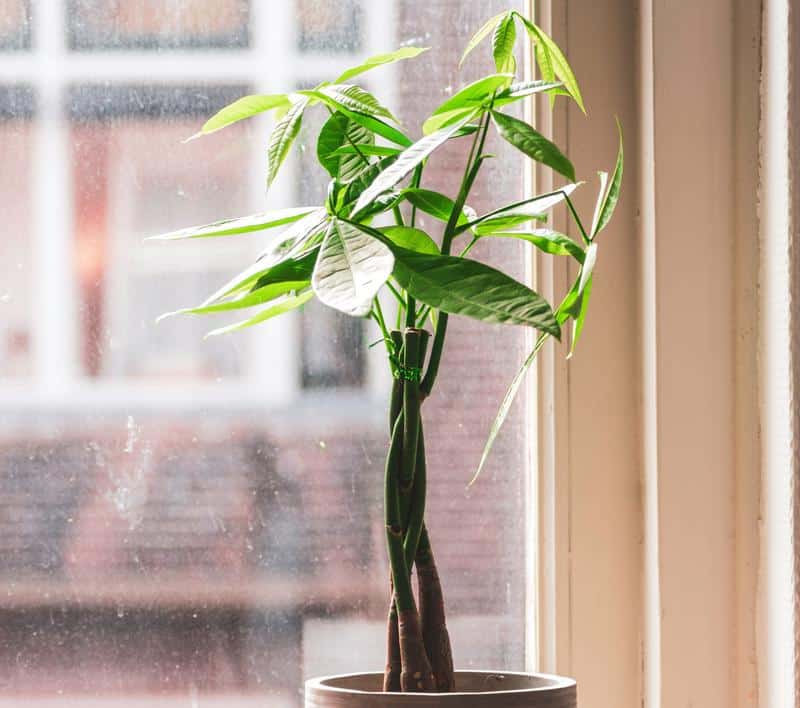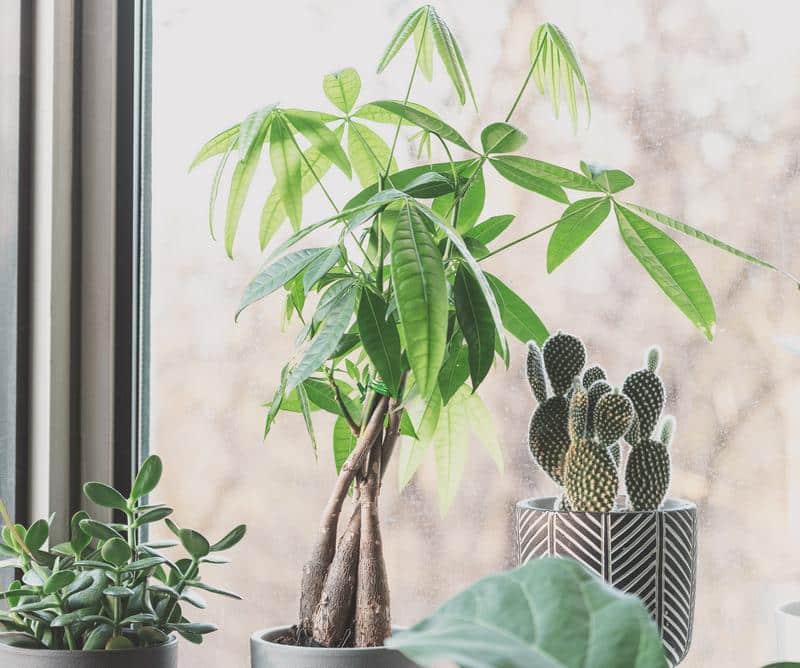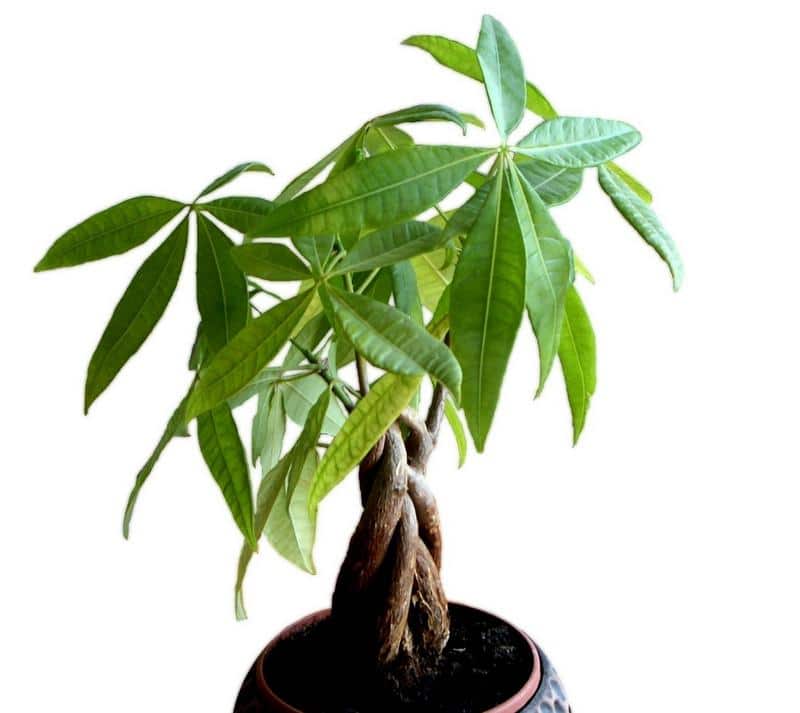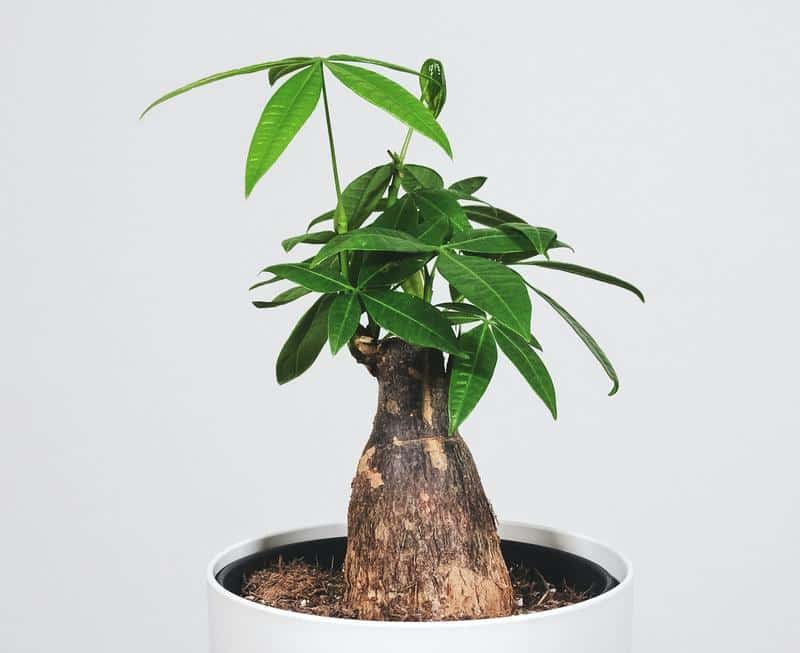Are Money Trees Toxic to Dogs? Are Money Trees Poisonous to Dogs?
Are Money Trees toxic to dogs? Are Money Trees poisonous to dogs? In this article, we’ll explain everything you need to know about if Money Trees are safe for dogs including what to do if your dog ate Money Tree leaves already. We’re then going to teach you the two commands that will make sure your dog behaves around Money Trees and other potentially toxic plants.
Next, we’ll explain more things you should know about Money Tree and dogs, such as how to keep dogs away from Money Trees using barriers and other methods. Finally, we’ll wrap all of this up by instructing you on proper Money Tree care (care indoors/outdoors, watering, potting, light requirements, common problems) and more to know when you have dogs. Keep reading!
Are Money Trees Toxic to Dogs?

Money Trees are not toxic to dogs. The popular houseplants are valued for their unique braided trunks and vibrant green leaves. However, it’s always best to prevent your dog from eating plants of any kind as it can lead to gastrointestinal upset and the formation of a potentially dangerous habit.
Are Money Trees Poisonous to Dogs?
Money Trees are not poisonous to dogs. Scientifically known as Pachira aquatica, it is recognized as non-toxic by the ASPCA and other pet health organizations. While ingestion of any plant material can cause minor stomach upset in dogs, Money Trees are not known to contain any harmful toxins that would pose a severe health risk.
Train the “Leave It” Command
One of the best preventive measures to ensure your dog doesn’t take a liking to your Money Tree is to train the “Leave It” command. This command instructs your dog to immediately cease what they are doing and turn their attention to you.
- Start with a treat in both hands.
- Close one fist and present it to your dog, saying “Leave it.”
- Wait until your dog stops sniffing and trying to get the treat, then reward them with the treat from the other hand.
- Practice regularly, increasing the challenge by placing the treat on the floor or using the plant itself.
Utilizing this command can prevent many unwanted behaviors, including plant nibbling.
Train the “Drop It” Command
If your dog has grabbed a leaf or piece of the Money Tree already, the “Drop It” command becomes invaluable. This command gets your dog to release whatever is in their mouth.
- Play a tug game with a toy your dog loves.
- At the peak of their interest, offer a high-value treat and say “Drop it.”
- As soon as your dog releases the toy, reward them with the treat.
- Gradually practice this with different objects, ensuring your dog generalizes the command.
These commands will keep your dog safe around Money Trees and other plants, but it’s important to remember that the underlying behavioral issues (curiosity, anxiety, boredom, etc.) that were causing all of this to begin with will still be present. And until you address those, any positive changes you see are only going to be temporary.
“Well, how do I make these changes last?”
By getting your dog to truly choose to follow your direction, that’s how. I tried many times to write out how you can do that before deciding it made more sense to just link you to the free video series that explains it better than I’d ever be able to.
The series is by a man named Dan who is one of the world’s leading dog obedience trainers. In it, he teaches you how to put an end to things like your dog chewing Money Tree leaves and all other misbehavior using his fast and easy-to-follow methods.
In the first video, Dan will reveal to you why the two most common methods of dog training only doom you to failure. You can watch the video now by clicking here. Follow the proven system he’ll show you in his series and you’ll never have to spend another second worrying about your dog eating Money Tree leaves ever again!
Are Money Trees Safe for Dogs?

Money Tree is not toxic to dogs. However, any plant ingestion can still lead to gastrointestinal discomfort for your pet. You should monitor your dog and take steps to ensure they don’t get into the habit of chewing or eating plants they’re curious about.
Dog Ate Money Tree Leaves, What Do I Do?
While Money Trees are not toxic to dogs, ingesting any plant can lead to minor stomach upset. If your dog ate Money Tree leaves in large amounts:
- Monitor them for signs of discomfort, such as vomiting, diarrhea, or excessive drooling.
- Ensure they have plenty of fresh water available to drink.
- If they show severe or prolonged symptoms, contact your veterinarian for advice.
Dog Eating Money Trees: How to Prevent
Prevention is key to ensuring your dog and Money Tree can coexist without incident. Here are some strategies to consider:
- Place the Money Tree in an area that’s inaccessible to your dog, perhaps on a high shelf or behind a barrier.
- Use deterrents, like bitter sprays, on the plant’s leaves. These are non-toxic and will make the plant taste unpleasant to your canine companion.
- Reinforce training commands such as “Leave It” or “Drop It” to dissuade interest in the plant. Learn both now in the first section.
What Attracts Dogs to Money Trees?
Several factors can pique a dog’s interest in plants, including:
- Curiosity: Dogs are naturally inquisitive animals and may nibble on plants to explore their environment.
- Texture: The soft, supple leaves of the Money Tree might be appealing to chew on, much like a toy.
- Taste: Some dogs might find the taste of certain plants appealing, even if they’re not particularly flavorful to humans.
While the Money Tree is not poisonous to dogs, you should still monitor any interactions between your pet and the plant. Through vigilant supervision, consistent training (learn how in the first section), and preventive measures, you can ensure that both your dog and your Money Tree remain safe and healthy in each other’s company.
You should get this problem taken care of right away, as it will also keep your dog safe around other plants. You then won’t have to stress about things like are Majesty Palms toxic to dogs, are Ponytail Palms toxic to dogs, are Banana Trees poisonous to dogs, or are Parlor Palms toxic to dogs.
Money Tree and Dogs

Money Tree is not toxic to dogs. However, even non-toxic plants can be a cause for concern if eaten in large amounts. So, while your Money Tree (Pachira aquatica) isn’t likely to harm your dog, it’s still important to understand the dynamic between the two and take necessary precautions.
How to Keep Dogs Away From Money Trees
Money Trees, with their appealing and lush green leaves, can be enticing for a curious dog. To ensure that your pet keeps its distance:
- Utilize barriers: Consider placing a decorative fence or barrier around the tree or using baby gates to block off rooms where you keep the plant.
- Position strategically: Keep the Money Tree on elevated surfaces, like shelves or tall stands, where dogs cannot easily reach.
- Apply safe deterrents: Spraying the leaves with a non-toxic bitter deterrent can make them unappealing to chew on.
Recognizing Signs of Plant Ingestion
Even though Money Trees are not poisonous to dogs, it’s still important to recognize if your dog has been nibbling on it or other plants:
- Physical evidence: Chewed or torn leaves and scattered soil are clear indicators.
- Behavioral signs: Excessive drooling, mild vomiting, or diarrhea can occur even with non-toxic plants.
- Monitor their habits: If your dog spends an unusual amount of time near the tree, they might be showing interest in it.
The Appeal of Plants to Dogs
Dogs might be drawn to plants for several reasons:
- Novelty: New additions to their environment can be intriguing.
- Texture: The unique texture of plant leaves can be enjoyable to chew.
- Attention: Sometimes, dogs might interact with items to get a reaction from their owners.
While Money Trees are safe for dogs, it’s always smart to be aware and take steps to avoid potential mishaps. With the right precautions in place, your dog and Money Tree can coexist harmoniously in the same space. Learn two commands that will help in the first section.
Money Tree Care

For those seeking an indoor plant that’s both visually appealing and relatively low-maintenance, the Money Tree might be a perfect fit. Widely regarded for its lush green leaves and unique braided trunk, the Money Tree is also famed for its supposed ability to bring prosperity and good luck.
Care of Money Trees
Money Trees, or Pachira aquatica, originate from Central and South America. They thrive in conditions that mimic their native environment, making them excellent houseplants.
- Watering: They prefer deep but infrequent watering.
- Soil: Well-draining soil is a must to prevent root rot.
- Temperature: Money Trees enjoy temperatures between 60-75°F (15-24°C).
Money Plants Indoor
Indoor care of Money Trees is relatively simple. Being native to rainforests, they enjoy indirect light and can tolerate some shade. While they appreciate humidity, they also adapt well to typical household environments. Placing them away from drafty windows or heating vents is ideal.
How Often to Water Money Tree
Watering frequency depends on the environment. Typically, you should water when the top 1-2 inches of soil feels dry. Overwatering or letting the plant sit in water can lead to root rot. Always ensure the pot has adequate drainage.
Money Trees Light Requirements
While they can tolerate some shade, Money Trees prefer bright, indirect light. Avoid direct sunlight, especially during peak hours, as it can scorch the leaves.
Potted Money Tree
When potting or repotting a Money Tree:
- Choose a container with good drainage.
- Use a well-draining potting mix, preferably one designed for succulents.
- Re-pot only when the tree becomes root-bound, typically every 2-3 years.
Money Tree Plant Problems
Common issues include yellowing leaves due to overwatering, browning leaf tips from low humidity, and pests like spider mites or aphids. Ensure proper watering, increase humidity if needed, and keep an eye out for pests.
Why Is It Called a Money Tree?
The Money Tree is believed to bring good luck and prosperity, particularly in Feng Shui practices. Its five leaves on each stem represent the five elements of nature: wood, water, earth, fire, and metal. This balance is thought to attract positive energy and wealth.
Money Tree Outdoors
In warmer climates, Money Trees can be grown outdoors. They prefer partial shade and well-draining soil. Ensure they’re protected from frost and extreme heat. Remember that even outdoors, they don’t require frequent watering.
Caring for a Money Tree can be a rewarding experience. They’re not just ornamental but are believed to bring prosperity and positive energy into homes. You also have the added assurance of knowing that the Money Tree plant is safe for dogs.
With proper care, your Money Tree can thrive and become a centerpiece in your living space. Learn two commands that will help keep your dog safe around all plants by going back to the first section now.
I’m sure it’s good to have all of your questions about Money Trees and dogs answered, so I’ll let you get started now. Good luck, and thanks for reading our article “Are Money Trees Toxic to Dogs? Are Money Trees Poisonous to Dogs?”





